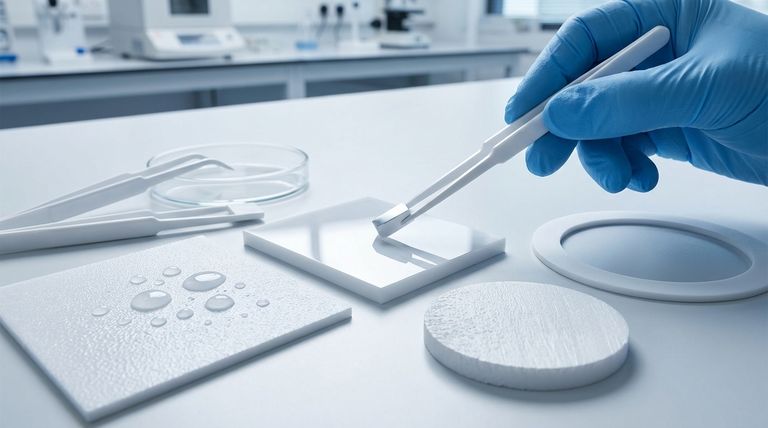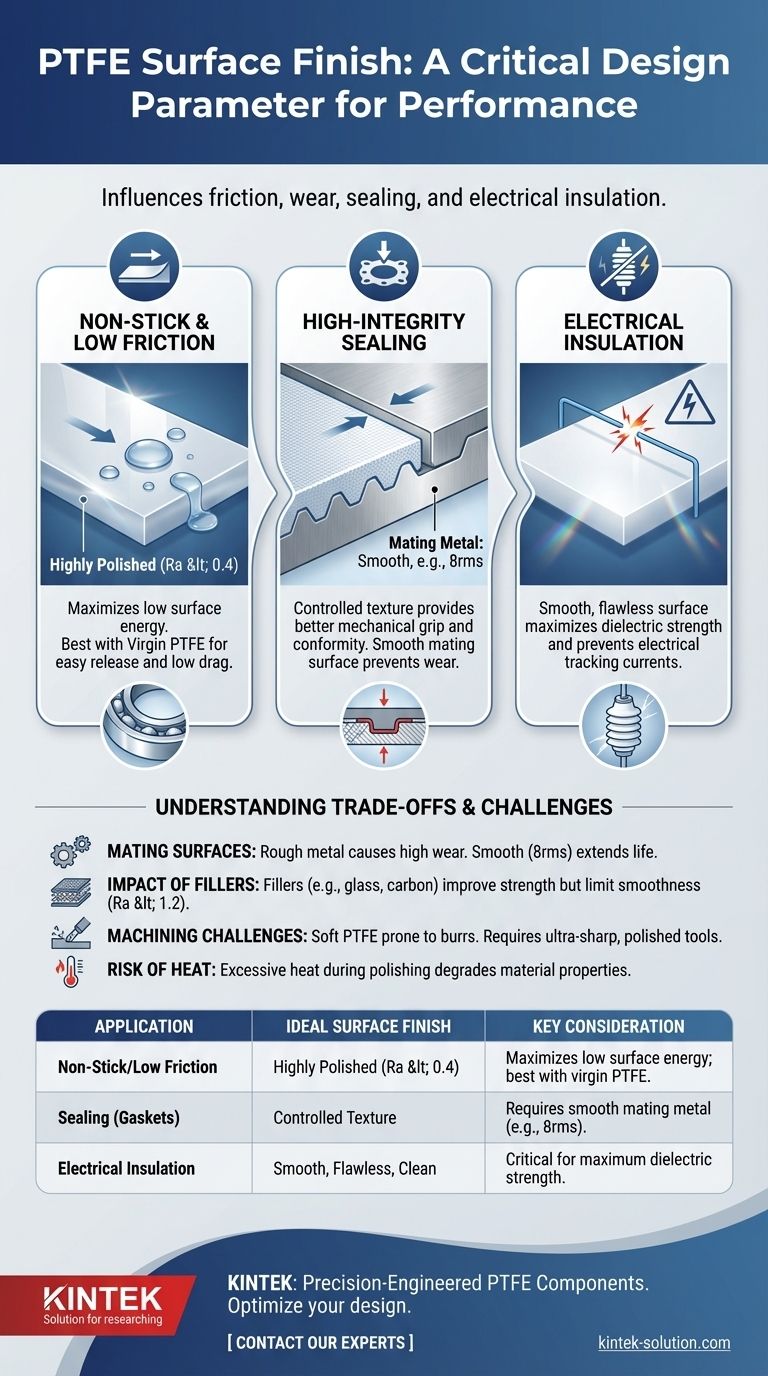The surface finish of a PTFE sheet is not a cosmetic detail; it is a critical design parameter that directly dictates the material's performance. Depending on the application—whether it's for a non-stick surface, a high-integrity gasket, or an electrical insulator—the required finish will change dramatically, influencing everything from friction and wear to sealing effectiveness.
The core principle is simple: the ideal PTFE surface finish is a deliberate choice tailored to the application's primary function. A smooth finish maximizes the material's inherent non-stick and insulating properties, while a controlled, textured surface is essential for mechanical grip in sealing applications.

Why Surface Finish is a Critical Design Choice
Beyond a Simple Specification
The surface of a PTFE component is the interface where all critical work happens. It's where the material must either slide without resistance, grip to form a seal, or resist the flow of electricity.
Specifying the finish is therefore as important as specifying the material's thickness or grade.
The Role of Low Surface Energy
PTFE is famous for its low surface energy, which is the root of its non-stick and water-repellent properties.
A smoother finish maximizes this characteristic, presenting the smallest possible surface area for other materials to adhere to, which is ideal for applications like food processing or low-friction bearings.
Matching the Finish to the Application
For Non-Stick and Low-Friction Surfaces
When the goal is minimal friction or creating a non-stick surface, a highly polished, smooth finish is required.
Virgin PTFE can be machined or polished to an exceptionally smooth finish (Ra < 0.4), making it perfect for applications where easy release or low drag is paramount.
For High-Integrity Sealing
For gaskets and seals, a textured surface provides better mechanical grip and conformity against the mating surface, creating a more effective barrier.
However, a finish that is too rough can create microscopic leakage paths. This is especially problematic when sealing small gas molecules, as PTFE itself has high gas permeability. The key is a controlled, consistent texture.
For Electrical Insulation
As an excellent electrical insulator, PTFE must have a clean, smooth, and contaminant-free surface to achieve its maximum dielectric strength.
Any surface imperfections, scratches, or embedded contaminants can create points of failure and compromise the material's ability to resist electrical tracking currents.
Understanding the Trade-offs and Machining Challenges
The Paradox of Mating Surfaces in Seals
The performance of a PTFE seal is critically dependent on the finish of the mating metal surface.
A rough metal surface (e.g., 16rms) will initially cause high wear on the PTFE seal. Over time, the crevices in the metal fill with a transfer layer of PTFE, which then reduces friction.
Improving the metal's finish (e.g., to 8rms) can significantly reduce this initial wear and as much as double the seal's operational life by preventing abrasive damage from the start.
The Impact of Fillers
Adding fillers like glass or carbon to PTFE enhances its mechanical properties like wear resistance and compressive strength.
However, these fillers interrupt the material's homogeneity, making it impossible to achieve the same ultra-smooth finish as virgin PTFE. Filled PTFE typically has a rougher best-case finish (around Ra < 1.2).
The Difficulty of Machining PTFE
PTFE's softness presents a significant machining challenge. It is prone to tearing and burr formation rather than cutting cleanly.
Achieving a superior finish requires ultra-sharp tools, typically made from high-speed steel or carbide with polished cutting edges and specific rake angles (0°–15°), to minimize material deformation.
The Risk of Heat During Polishing
Post-machining processes like buffing or mechanical polishing with soft pads can refine the surface.
However, care must be taken to avoid excessive heat generation. Overheating PTFE can alter its molecular structure and degrade its mechanical and chemical properties, negating the benefits of the improved finish.
How to Specify the Right Finish for Your Project
To ensure optimal performance, your specification must align with the component's primary function.
- If your primary focus is non-stick performance or low friction: Demand the smoothest possible finish, often best achieved with virgin PTFE and post-processing like polishing.
- If your primary focus is sealing gases or liquids: Specify a controlled texture on the PTFE and, more importantly, a smooth finish (e.g., 8rms) on the mating metal surface to minimize wear and potential leak paths.
- If your primary focus is high-voltage electrical insulation: Prioritize a smooth, flawless, and contaminant-free surface to guarantee maximum dielectric strength.
Treating the surface finish as a primary design input is the key to unlocking the full potential of PTFE in your application.
Summary Table:
| Application | Ideal PTFE Surface Finish | Key Consideration |
|---|---|---|
| Non-Stick / Low Friction | Highly Polished (Ra < 0.4) | Maximizes low surface energy; best with virgin PTFE. |
| Sealing (Gaskets) | Controlled Texture | Requires a smooth mating metal surface (e.g., 8rms) to prevent wear. |
| Electrical Insulation | Smooth, Flawless, Clean | Critical for maintaining maximum dielectric strength and preventing failure. |
Need a PTFE component with a precision-engineered surface finish?
At KINTEK, we understand that the right surface finish is critical to the performance of your PTFE seals, liners, and labware. Whether your application is in the semiconductor, medical, laboratory, or industrial sector, our expertise in custom PTFE fabrication ensures your components are machined to the exact specifications required for optimal function—from prototypes to high-volume orders.
Let us help you optimize your design. Contact our experts today for a consultation!
Visual Guide

Related Products
- Custom PTFE Parts Manufacturer for Teflon Parts and PTFE Tweezers
- Custom PTFE Parts Manufacturer for Teflon Containers and Components
- Custom PTFE Sleeves and Hollow Rods for Advanced Applications
- Custom PTFE Sealing Tapes for Industrial and High Tech Applications
- Custom PTFE Square Trays for Industrial and Laboratory Use
People Also Ask
- What challenges arise when machining PTFE (Teflon)? Overcome Softness, Heat, and Instability
- What are the unique properties of PTFE? The 3 Pillars Driving Demand for High-Performance Parts
- What factors should be considered when choosing between Nylon and PTFE? Select the Right Material for Your Application
- What are the unique properties of PTFE? Unlock Unmatched Performance in Demanding Applications
- What fabrication services are available for PTFE? Shearing, Stamping, Laser Cutting, Molding & Machining



















